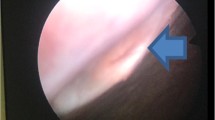Abstract
Purpose
We present a long-term follow-up of patients who underwent VUR correction with polyacrylate polyalcohol copolymer (PPC) injection with an emphasis on UVJ obstruction and urinary tract infection.
Methods
During 2009–2012, 157 children (106 girls and 51 boys) with mean age of 4.8 ± 2.8 years (mean ± SD) underwent endoscopic correction of VUR using PPC. VUR was unilateral in 74 patients and bilateral in 83, comprising 240 renal reflux units (RRU). Of these, primary VUR was present in 197 RRU (82.1%) and 43 (17.9%) were complex cases. Median follow-up was 7 years (range 6–10 years). Average volume of PPC was 1.2 ml (range 0.6–1.8 ml)
Results
Reflux was corrected in 222 RRU (92.5%) after a single injection, and in 10 RRU (4.2%) after the second injection. In RRU 7 (2.9%), reflux downgraded to Grade I and II, and they were taken off antibiotic prophylaxis. One patient (0.4%) failed endoscopic correction and required ureteral reimplantation (UR). 11 (4.6%) RRU developed UVJ obstruction, of which 9 (3.8%) required UR. All patients developed obstruction between 1 and 2 years after injection. Nineteen (12.1%) patients developed low UTI, and 12 (7.6%) patients developed febrile UTI during follow-up. None of these patients demonstrated reflux recurrence.
Conclusion
Our data indicate that endoscopic correction utilizing PPC does not increase the risk of obstruction during long-term follow-up.


Similar content being viewed by others
References
Chertin B, Arafeh WA, Zeldin A, Kocherov S (2011) Preliminary data on endoscopic treatment of vesicoureteric reflux with polyacrylate polyalcohol copolymer (Vantris): surgical outcome following single injection. J Pediatr Urol 7:654–656
Kocherov S, Ulman I, Nikolaev S et al (2014) Multicenter survey of endoscopic treatment of vesicoureteral reflux using polyacrylate-polyalcohol bulking copolymer (Vantris). Urology 84(3):689–693
Chertin B, Kocherov S (2010) Long-term results of endoscopic treatment of vesicoureteric reflux with different tissue-augmenting substances. J Pediatr Urol 6(3):251–253
Chertin B, Mele E, Kocherov S, Zilber S, Gerocarni Nappo S, Capozza N (2018) What are the predictive factors leading to ureteral obstruction following endoscopic correction of VUR in the pediatric population? J Pediatr Urol 14(538):e1e538-7
Alizadeh F, Mazdak H, Khorrami MH, Khalighinejad P, Shoureshi P (2013) Postoperative ureteral obstruction after endoscopic treatment of vesicoureteral reflux with polyacrylate polyalcohol copolymer (Vantris). J Ped Urol 9:488–492
Sencan A, Yıldırım H, Ozkan KU (2014) Late ureteral obstruction after endoscopic treatment of vesicoureteral reflux with polyacrylate polyalcohol copolymer. Urology 84:1188–1191
Sharifiaghdas F, Tajalli F, Otukesh H (2014) Shamsabadi RH Endoscopic correction of primary VUR by using polyacrylate polyalcohol copolymer (Vantris) in young girls: 2-year follow-up. J Ped Urol 10(6):1032–1036
Warchoł W, Krzemień G, Szmigielska A, Bombiński P, Toth K, Dudek-Warchoł T (2017) Endoscopic correction of vesicoureteral reflux in children using polyacrylatepolyalcohol copolymer (Vantris): 5-years of prospective follow-up. Cent Eur J Urol 70:314–319
García-Aparicio L, Blázquez-Gómez E, Martin O et al (2018) Randomized clinical trial between polyacrylate-polyalcohol copolymer (PPC) and dextranomer-hyaluronic acid copolymer (Dx/HA) as bulking agents for endoscopic treatment of primary vesicoureteral reflux (VUR). World J Urol 36(10):1651–1656
Report of the International Reflux Study Committee (1981) Medical versus surgical treatment of primary vesicoureteral reflux: a prospective international reflux study in children. J Urol 125:277–280
Puri P, Chertin B, Velayudham M, Dass L, Colhoun E (2003) Treatment of vesicoureteral reflux by endoscopic injection of dextranomer/hyaluronic acid copolymer: preliminary results. J Urol 170:1541–1544
Chertin B, De Caluwé D, Puri P (2003) Endoscopic treatment of primary grades IV and V vesicoureteral reflux in children with subureteral injection of polytetrafluoroethylene. J Urol 169(5):1847–1849
Griffiths DJ (1989) Flow of urine through the ureter: a collapsible, muscular tube undergoing peristalsis. J Biomech Eng 111(3):206–211
Friedmacher F, Puri P (2019) Ureteral obstruction after endoscopic treatment of vesicoureteral reflux: does the type of injected bulking agent matter? Curr Urol Rep 20:40–49
Funding
None.
Author information
Authors and Affiliations
Contributions
All authors contributed equally to the study. This retrospective study from two centers with seven pediatric surgeons/urologists.
Corresponding author
Ethics declarations
Conflict of interest
The authors declare that they have no conflict of interest.
Ethics approval
Study received approval of ethical committees from both institutions.
Rights and permissions
About this article
Cite this article
Kocherov, S., Nikolaev, S., Gaber, G. et al. Incidence of UVJ obstruction during long-term follow-up after endoscopic correction of VUR utilizing polyacrylate polyalcohol copolymer (PPC). J Ped Endosc Surg 2, 183–187 (2020). https://doi.org/10.1007/s42804-020-00078-2
Received:
Revised:
Accepted:
Published:
Issue Date:
DOI: https://doi.org/10.1007/s42804-020-00078-2




